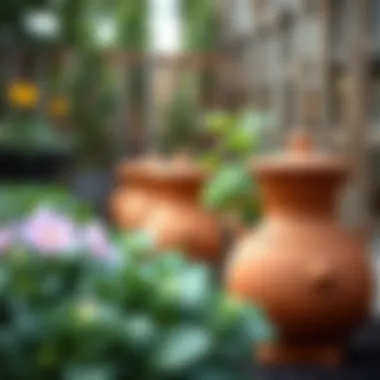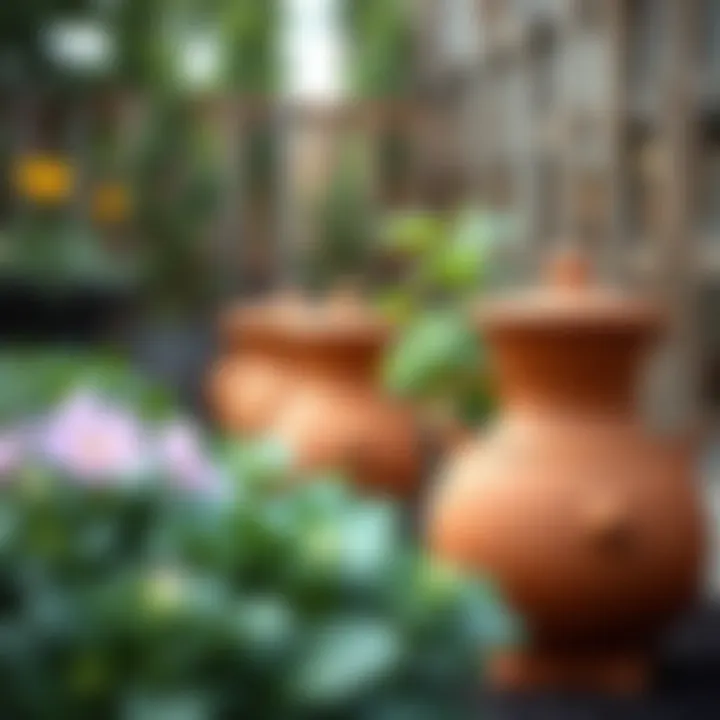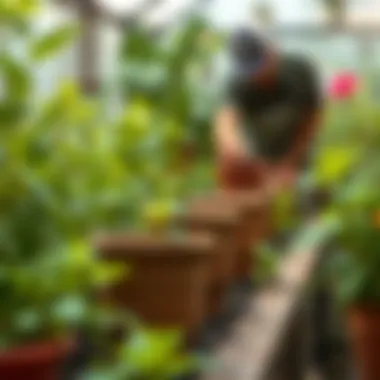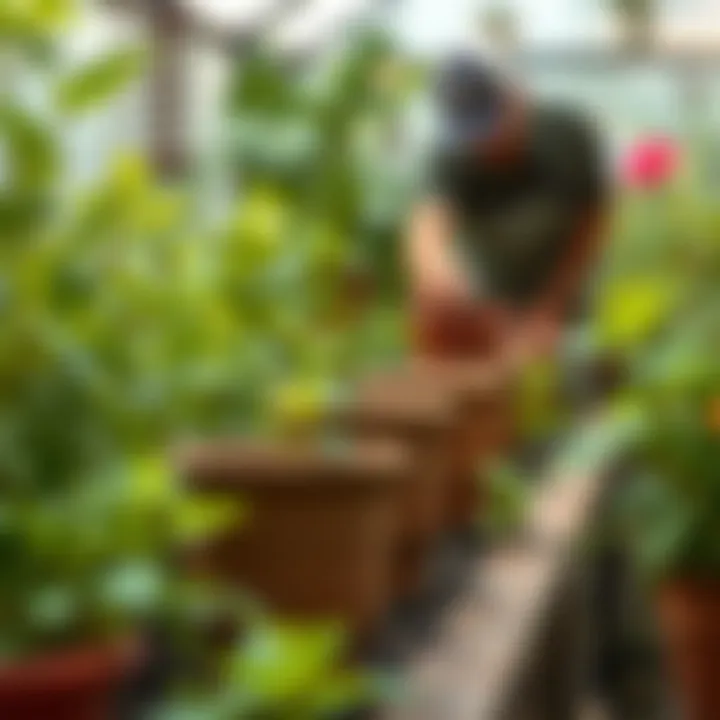Maximize Soil Moisture with Clay Plant Waterers


Intro
In the world of gardening, moisture management sits squarely at the heart of plant health and growth. Whether you are tending to a verdant indoor jungle or nurturing a flourishing backyard garden, maintaining the right level of soil moisture is crucial. This is where clay waterers come into play, serving as a traditional yet undeniably effective method for hydration. Crafted from terracotta and used for centuries, these unassuming objects are not just pieces of pottery; they are an artful solution to a common gardening challenge.
Utilizing clay plant waterers can revolutionize how gardeners care for their plants. They offer a straightforward approach to delivering consistent moisture while also contributing to soil aeration. Imagine a scenario where you can keep your plants quenched without worrying about overwatering or under-watering, which frequently plagues even the most experienced gardeners. This is the promise of clay waterers.
In this article, we will explore the design, functionality, and advantages of clay plant waterers, showing how they stand out against competing watering methods. We'll delve into effective maintenance practices to ensure that these waterers remain functional and visually appealing. Additionally, we will compare their benefits to other common techniques, offering a comprehensive outlook on how to effectively incorporate these devices into your gardening routine. Let's dig deeper into this topic and discover how clay plant waterers can enhance your gardening experience and promote healthier plant life.
Intro to Clay Plant Waterers
In the realm of gardening, the method of watering plants often determines their overall health and growth. Clay plant waterers stand out in this context, providing a unique blend of functionality and aesthetic appeal. These terracotta devices, sometimes referred to as ollas, serve not only as a vessel for water but also as a strategic tool in moisture management. By incorporating these waterers into both indoor and outdoor gardens, gardeners can facilitate a more sustainable approach to plant care.
Definition and Purpose
Clay plant waterers are earthenware containers designed to deliver water directly into the soil surrounding them. Their design relies on the principles of capillary action, allowing water to seep through the walls of the clay pot and into the surrounding soil. When positioned underground, these waterers minimize evaporation by placing water where it’s needed most—right at the plant's roots.
The primary purpose of clay waterers is to maintain soil moisture levels consistently. This indirect watering method reduces the frequency of watering, making it an appealing option for individuals with busy schedules or for those who may often forget to water their plants regularly. A key element here is the efficiency of water usage; because water is slowly released where plants can absorb it, there is less waste.
Historical Context
The concept of using clay for water storage isn't a newfangled idea. Historically, these waterers have been a staple in various cultures, especially in arid regions where water scarcity posed a significant problem. Ancient civilizations, such as the Chinese and the indigenous peoples of the Americas, employed similar techniques for sustainable agriculture.
According to records, terracotta containers have been in use for thousands of years, with archeological discoveries pointing to their effectiveness in ancient farming methods. The revival of these techniques in modern gardening relates closely to today’s emphasis on sustainability and water conservation. By harnessing traditional knowledge about clay waterers, contemporary gardeners are not only acknowledging their roots but also innovating for a more sustainable future.
"In a world that often celebrates the new, there is profound wisdom in the tried and true methods of our ancestors." - Gardening Enthusiast
In summary, clay plant waterers serve as a merging point between ancient tradition and modern gardening practices. Their ability to provide consistent moisture while allowing gardeners to minimize their time and effort is invaluable. As we progress through this article, the intricate relationship between the design, function, and benefits of clay waterers will unfold, shedding light on their essential role in efficient gardening.
Understanding the Design of Clay Waterers
When exploring the use of clay plant waterers, understanding their design is essential, as it lays the groundwork for appreciating how and why they function effectively. The design elements directly relate to the benefits they can provide for both plants and gardeners alike. This design encompasses not just aesthetics, but also practicality and efficiency in moisture management.
Materials and Construction
Clay waterers are typically crafted from terracotta, a natural resource that’s been around for centuries. The porous nature of terracotta is no mere accident; it is a deliberate choice that enhances the functioning of these waterers. Unlike plastic or metal options, clay allows water to seep through its walls, providing a gradual moisture release into the surrounding soil. This characteristic warrants proper drainage, preventing root rot and encouraging healthy plant development.
Moreover, the construction process of these waterers often involves traditional handcrafting, particularly in artisanal designs. This not only adds unique character to each piece but also ensures quality over mass manufacturing. Durability is another consideration; while some might think clay is fragile, high-quality terracotta can withstand both winter frost and summer heat, making it a reliable choice for long-term use.
Shapes and Size Variations
When it comes to shapes and sizes, clay waterers are as diverse as the plants they serve. From tall and narrow designs that are perfect for rooting vegetables, to wider, squat forms suited to flower beds, having the right shape can significantly impact a plant's growth. Different shapes allow gardeners to nestle these waterers into various garden layouts or even display them decoratively on patios.
The size of a clay waterer is equally critical—too small for the needs of a plant, and it may not deliver enough moisture. Conversely, a waterer that is overly large may oversaturate the soil, leading to detrimental consequences. Hence, taking into account the specific plant type, soil, and environmental conditions can help one choose the right fit. In cases with multiple plants, using several smaller waterers can ensure that each plant receives an even distribution of moisture without risking overwatering any single one.
"The design of clay waterers should not merely be an afterthought, but rather an integral component of an effective gardening strategy."
Ultimately, understanding the design elements allows gardeners not just to use a tool effectively, but to appreciate the beauty and functionality of it as well. Fostering this awareness is a pivotal step in optimizing moisture management, which can lead to healthier, more vibrant plants.
Mechanics of Water Distribution
Water distribution in gardening is not just about dousing plants with water every now and then—it's an intricate ballet of moisture management that significantly affects plant health. Understanding the mechanics behind how clay plant waterers work is key to maximizing their benefits, making this section crucial as we delve into the specific dynamics that facilitate efficient watering.
Capillary Action Principles
At the heart of how clay waterers operate lies the principle of capillary action. This natural phenomenon is driven by the interplay of attraction between water molecules and the porous clay material. To put it simply, when you fill a clay waterer with water, the moisture seeps into the tiny pores of the clay. As the soil surrounding the waterer dries out, it creates a slight vacuum that pulls the water through the pores of the clay and into the soil.
- Hydrophilic Nature of Clay: Clay has a unique attraction to water, making it exceptionally good at absorbing moisture.
- Movement of Water: This capillary action allows for a slow and steady release of water, ensuring that plants receive hydration consistently over time.
- Moisture Control: By allowing water to flow through the clay, gardeners can avoid the sudden influx that often leads to waterlogging, which can suffocate plant roots.
Understanding these principles equips gardeners to use clay plant waterers effectively. Rather than relying solely on human judgment to administer water, the physics of capillary action facilitates an intelligent distribution system, thereby liberating the gardener from the tedious task of constant monitoring.
"Plants don’t just drink water; they draw in moisture through the soil, making capillary action the unsung hero of hydration in gardening."
Soil Interaction Dynamics
The dance between water and soil is equally important. When using clay plant waterers, the interaction between the moist clay and the surrounding soil creates a balanced ecosystem that optimizes moisture levels. Initially, water is drawn from the waterer into the soil, but that's just part of the story.
- Soil Structure Influence: Different types of soil—sandy, loamy, or clay-based—affect how water moves through the ground. Sandy soil drains quickly, while clay soil tends to hold moisture, thus shaping how effective a clay waterer might be.
- Microbial Life: Constant moisture at the root zone promotes a thriving microbial ecosystem, essential for plant growth. Good microbial activity in healthy soil leads to better nutrient uptake.
- Soil Compaction: Over time, soil can become compacted, hindering water movement. Using clay waterers can help mitigate this, as consistent moisture encourages expansion and loosening of soil particles.
As you consider your gardening strategy, it becomes clear that the mechanics of water distribution are much more than mere watering; they encompass an entire philosophy on how we approach nurturing plants. The synergy between clay waterers and the soil establishes a sustainable relationship where both elements work together for optimal moisture management.
Benefits of Using Clay Plant Waterers
When it comes to nurturing plants, watering techniques can make all the difference. Clay plant waterers have carved out a reputable niche in the gardening community, offering a variety of benefits that enhance soil moisture management. Understanding the significance of these benefits not only aids in healthier plants but also influences sustainable gardening practices. Let's explore the key advantages of using clay plant waterers, focusing on their unique features and how they can transform your gardening experience.
Water Retention and Regulation
Clay plant waterers excel in the realm of moisture retention. The porous nature of clay allows for gradual water release, which keeps soil consistently moist without saturation. This means plants have a steady supply of water available, which is particularly crucial during drier seasons.


One of the key advantages is the ability of the clay to act as a natural reservoir. As water seeps through the material, it permeates the surrounding soil. This gradual distribution helps maintain even moisture levels, reducing the likelihood of dry spots that could stress plants. When utilizing a clay waterer, gardeners can enjoy a hands-off approach. It’s like having a personal watering assistant—just fill it up, and let it do its job.
Additionally, the natural evaporation from the waterer can create a microclimate that benefits plant growth. A consistent moisture level in the soil supports root development, improves nutrient uptake, and promotes overall plant vigor. The result? Lush, vibrant foliage and bountiful blooms.
Sustainable and Low Maintenance
In an age where sustainability is more important than ever, clay plant waterers align beautifully with eco-friendly gardening practices. Made from natural materials, these waterers offer a sustainable alternative to plastic containers that contribute to environmental waste.
Using clay also means less frequent watering for the gardener. The design allows plants to siphon off only the water they need as they need it. This efficiency not only conserves water but also minimizes the time spent on maintenance.
Here’s a quick list of sustainable aspects:
- Natural Material: Clay is biodegradable and does not add harmful toxins to the environment.
- Water Conservation: Less water usage means more resources saved in the long run.
- Durability: With proper care, clay waterers can last for years, providing a long-term solution without the replacement need typical of plastic options.
This low maintenance feature is a boon for both novice and seasoned gardeners. They can focus on enjoying their plants rather than fretting over watering schedules.
Reduction of Overwatering Risks
Overwatering is a common pitfall that many gardeners face, leading to root rot and other issues. Clay plant waterers significantly reduce this risk. Since they release water slowly, they help to prevent the oversupply that can sometimes occur with traditional watering methods—especially for novice gardeners who might not have a keen sense of when to stop pouring.
By using a clay waterer, gardeners can trust that their plants are getting the right amount of water. The water saver ensures that the soil remains moist, but not drenched. This is particularly important for plants sensitive to wet conditions.
To illustrate this, consider the difference between a clay waterer and a typical watering can:
- Clay Waterer: Releases water gradually, allowing the plant to absorb without flooding.
- Watering Can: A quick pour can easily lead to excess water, especially if the gardener isn't playing close attention.
"A clay waterer acts as a buffer against user error, ensuring your plants get just what they need—nothing more, nothing less."
In summary, clay waterers not only streamline the watering process but also create an environment conducive to healthy plant growth. In a world where every drop counts, these waterers emerge as a favoured choice for gardeners aiming for sustainability and efficiency.
Comparing Clay Waterers with Other Watering Methods
When it comes to maintaining optimal moisture levels in the garden, the method of watering can greatly influence both plant health and overall garden success. This section delves into a comparative analysis of clay plant waterers against various popular watering techniques, highlighting their unique benefits, drawbacks, and use-case relevance. Understanding these differences empowers gardeners—be they novices or seasoned experts—to select the method that aligns with their gardening goals.
Versus Drip Irrigation Systems
Drip irrigation systems have gained a reputation for efficiency. They deliver water directly to the plant roots through a series of tubes and emitters, reducing evaporation and runoff. However, while effective, they can come with significant initial setup costs and ongoing maintenance. Clay waterers, on the other hand, offer a more straightforward solution.
- Cost-Effectiveness: Clay pots are usually much cheaper to purchase than comprehensive drip systems. For gardeners looking for simplicity without breaking the bank, clay waterers present a practical choice.
- Simplicity: Unlike drip systems that require planning and installation, clay waterers can be placed directly into the soil, needing little setup beyond their placement.
- Flexibility: Clay waterers can be moved easily depending on the needs of the plants or changes in gardening design, whereas drip irrigation often requires more effort and strain to modify.
Overall, while drip systems excel in certain large-scale agricultural scenarios, the user-friendly nature and affordability of clay waterers can make them a superior choice for smaller gardens or hobbyists.
Versus Traditional Watering Cans
Traditional watering cans, while familiar to most gardeners, may not always provide the best moisture management, especially for plants that have specific watering needs.
- Even Distribution: Clay waterers leverage the natural process of capillary action to deliver moisture gradually, which can help prevent waterlogging and encourage strong root growth. In comparison, a watering can might douse a plant unevenly, risking both under and over-watering.
- Labor Intensity: Using a watering can can be labor-intensive, especially for a larger garden. Carrying and pouring water becomes tedious very quickly. Clay waterers, however, require less frequent attention as they can maintain moisture levels over extended periods.
- Water Quality: Clay pots can naturally filter water, leading to a more balanced moisture level. Watering cans, depending on their material and cleanliness, might introduce contaminants.
In many scenarios, particularly with potted plants or delicate seedlings, clay waterers provide a more reliable and careful approach to watering than traditional methods.
Versus Automatic Sprinkler Systems
Automatic sprinkler systems cater to convenience, delivering moisture on a timed schedule. However, they can also lead to issues if not adequately calibrated.
- Customization: Clay waterers can be tailored to individual plants, allowing for a more hands-on approach to watering that automatic systems might not achieve without complex programming.
- Water Waste: Sprinklers often lead to water waste through evaporation, runoff, or misting. Clay waterers minimize this waste by allowing water to seep directly into the soil.
- Reliance on Technology: Automatic systems depend on complex technology, which can fail or malfunction. Clay waterers are low-tech and require minimal, if any, training to use.
Though automatic sprinklers can cover large areas efficiently, many gardeners may appreciate the more intimate, sensory connection to their plants provided by using clay waterers.
By weighing these comparisons, gardeners can find a watering solution that truly meets their needs, maximizing plant health and garden flourishing.
Choosing the Right Clay Waterer
Selecting the right clay waterer is essential for achieving optimal moisture management in your garden. Different plants have different needs, and the choice of a suitable waterer can significantly affect their health and growth. With a bit of understanding about your plant types and pot sizes, you can make an informed decision that enhancesyour gardening success.
Choosing the right clay waterer involves understanding both the characteristics of your plants and the physical attributes of the waterer itself. A seasoned gardener knows that not all plants respond the same way to watering techniques. The right system can ensure that plants get just the right amount of moisture, no more, no less.
Considerations Based on Plant Types
When picking a clay waterer, it’s critical to consider the specific needs of the plant species you are working with. Different plants have varying moisture and drainage requirements. For instance, succulents like Echeveria thrive in well-drained soils and may not need continuous moisture; a smaller or less permeable clay waterer would be beneficial for them.
Conversely, tropical plants, requiring more consistent moisture, might do well with a larger, more porous clay waterer that can release humidity gradually. Here are some considerations to ponder:
- Soil Needs: Sandy, well-drained soils might require a different watering strategy compared to dense, loamy soils.
- Root Depth: Deeper-rooted plants will benefit from a waterer that provides hydration at greater depths.
- Plant Size: Larger plants generally need more moisture, so select a bigger waterer.
"Understanding your plants' hydration needs is half the battle in successful gardening."
Size Recommendations for Various Pot Types
The size of your clay waterer should correspond to the type and size of the pots you are using. A common rule of thumb is that larger pots typically require larger waterers. If you’ve got a standard-sized pot, generally a waterer that holds between 0.5 and 1 gallon should suffice.


Here’s a quick guide to help you out:
- Small Pots (Under 6 inches): Using a waterer of 0.25 gallons or less can prevent over-saturation.
- Medium Pots (6 to 12 inches): A waterer of around 0.5 gallons will usually suffice for these.
- Large Pots (Over 12 inches): You might need a 1-gallon or more waterer, depending on the plant type.
The trick is to tailor your choice based on the combination of these factors. The result? A healthier, happier garden that’s poised to thrive under your care.
Choosing the right clay waterer should not feel overwhelming. By taking a thoughtful approach in aligning the waterer’s specs with your plants’ unique requirements, you create a customized watering strategy that encourages plant vitality.
Installation and Usage Guidelines
When it comes to maintaining optimal soil moisture, the way gardeners set up and use clay plant waterers plays a crucial role. These guidelines offer insights into best practices for installation and usage that can maximize the benefits of clay waterers. Understanding these aspects helps ensure that plants receive the right amount of water, reduces the stress of maintaining consistent soil moisture, and promotes healthier plant growth.
Setting Up Clay Waterers
The setup of clay waterers is relatively straightforward, yet a few key considerations can make a significant difference in their effectiveness. First, choosing the right location in the garden or on the windowsill is essential. Make sure the waterer is accessible for refilling but also positioned where it can best serve the plants.
Start by digging a hole in the soil where you want to place the clay waterer. The size of the hole should be a bit larger than the base of the waterer, allowing it to sit snugly without being too tight. It's beneficial for the tip of the waterer to be just below the surface to enable easy access to moisture by plant roots.
Once the waterer is in place, fill it with water and allow it to soak in. This process may take a little while, but it’s important as it helps establish the capillary action that allows moisture to be delivered into the soil. Regularly check the water levels and avoid overfilling, which can lead to waterlogging and potentially harm your plants.
Key steps for setting up a clay waterer:
- Choose an appropriate location for maximum effectiveness
- Dig a hole that fits the waterer's base comfortably
- Make sure the waterer’s neck is just below soil level
- Fill with water and allow time for saturation
- Regularly monitor water levels to prevent overfilling
Watering Frequency Considerations
Determining how often to refill clay waterers is critical. Generally, the frequency of watering depends on a few factors, including the type of plants, climate, and the size of the waterer itself. For instance, larger pots and more established plants may require less frequent refills as their root systems can access the moisture more effectively.
In warm climates, where evaporation rates are higher, it might be necessary to check the water levels more often. Conversely, in cooler conditions, the soil may retain moisture longer, allowing for longer intervals between water refills. Keep an eye on your plant's leaves as well; wilting or yellowing could indicate that adjustments are needed in your watering approach.
A good rule of thumb is to check the waterer every few days, especially during the growing season. By paying attention to these factors, you can fine-tune your refilling schedule to meet the specific moisture needs of your plants.
Tips for managing watering frequency:
- Observe your plants' health for signs of moisture stress
- Adjust frequency based on climate conditions
- Monitor waterer levels at least every few days
- Experiment until you find the right balance for your specific plants
By following these installation and usage guidelines, gardeners can harness the full potential of clay plant waterers, promoting optimal moisture management and a thriving garden.
"The art of gardening is all about understanding your plants' needs—location and moisture are key allies in this journey."
For further reading on gardening techniques and plant care, consider exploring resources from University of California Agriculture and Natural Resources or visiting the American Horticultural Society.
Maintaining Clay Plant Waterers
Maintaining clay plant waterers is crucial for ensuring their effectiveness in managing soil moisture. Unlike other watering methods that may require continuous adjustments or replace large portions of water, clay waterers offer a more stable and consistent moisture release. However, this stability comes with its own set of responsibilities. Proper care not only extends the lifespan of these waterers but also optimizes their benefits, resulting in healthier plants and more productive gardens.
Cleaning and Storage Tips
When it comes to cleaning clay waterers, one must strike a balance between diligence and delicacy. Here are some essential steps to keep your waterers in tip-top shape:
- Rinse Regularly: After each watering cycle, give your waterers a quick rinse with clean water. This helps remove any debris or algae that may build up, preventing blockages.
- Use Mild Detergents: If you notice stubborn residues, a gentle scrub with a soft brush using mild dish soap can do wonders. Avoid harsh chemicals, as they might seep into the porous clay and affect soil quality.
- Air Dry Thoroughly: Before storing, ensure your waterers are completely dry. Moisture left in the clay can lead to mold growth and unpleasant odors.
- Store in a Cool, Dry Place: When not in use, keep the waterers in a shaded or cool area. Direct sunlight can lead to cracking, especially in high temperatures.
Staying on top of these tasks ensures that your clay waterers remain functional and aesthetically pleasing.
Dealing with Mineral Deposits
Over time, water, especially tap water, tends to leave behind mineral deposits that can clog the pores of your clay waterers. Here’s how to effectively deal with these unsightly and obstructive build-ups:
- Vinegar Soak: Submerge the affected waterers in a solution of vinegar and water (1:1 ratio) for several hours. The acidity of vinegar effectively dissolves mineral build-up without damaging the clay.
- Gentle Scrubbing: Even after soaking, some deposits might still cling stubbornly. A non-abrasive scrub pad or soft brush can help eliminate residual deposits.
- Rinse Well: After scrubbing, rinse thoroughly with clean water to remove any vinegar residue and loosened minerals.
- Regular Maintenance: To avoid excessive mineral build-up in the first place, consider using distilled water or rainwater when filling your waterers, as these options contain fewer minerals compared to regular tap water.
By diligently addressing mineral deposits, you not only prolong the life of your clay waterers but also ensure a cleaner and healthier watering environment for your plants.
"Regular maintenance is the key to optimal performance. Just like with any tool, the better care you take of it, the longer it serves you well."
Impact on Plant Health
The use of clay plant waterers plays a significant role in maintaining the health of plants by addressing various key factors that influence growth and vitality. The gentle release of moisture and the consistent hydration provided by these waterers ensure that plants receive a balanced supply of water without the extremes of dryness or saturation. This consistency is essential for both the short-term and long-term well-being of plants, making it a valuable tool for any gardener.
Impact on Soil Quality
Clay waterers contribute positively to soil quality through the regulation of moisture levels, which affects the biological activity and structure of the soil. When clay waterers release water slowly, they foster a stable environment for beneficial microorganisms. These tiny, but mighty, players are crucial for nutrient cycling, as they help break down organic matter, making nutrients available to plants.
Moreover, consistent moisture encourages earthworm activity, improving soil aeration and structure. Good soil quality, achieved through moisture management via clay waterers, not only supports healthy root systems but also promotes better drainage and nutrient retention. If the soil stays too dry, important nutrients can become locked away, preventing plants from absorbing them properly. Conversely, overwet conditions can lead to compaction and a decrease in necessary air pockets. Overall, the use of clay waterers ensures that soil remains healthy, benefiting the plants above.
Long-term Effects on Plant Growth
Integrating clay waterers into gardening practices can yield significant long-term benefits for plant growth. With consistent moisture levels provided by these devices, plants tend to develop stronger root systems that are more resilient to environmental stressors such as drought or temperature fluctuations. Stronger roots allow plants to access nutrients effectively, leading to improved growth rates and lush foliage.
Furthermore, healthy moisture management promotes flowering and fruiting in many plant species. When plants are not stressed due to insufficient or excessive watering, they are more likely to produce blooms and fruits abundantly. This, in turn, can lead to higher yields for those cultivating food crops or more vibrant displays for ornamental plants.


The essence of optimal growth in plants can be drawn back to one core principle: they thrive when their moisture needs are steadily met.
Common Misconceptions about Clay Waterers
When diving into the world of clay plant waterers, various myths can mislead gardeners. Understanding these misconceptions is crucial in properly appreciating and selecting the right watering techniques for your plants. Let’s clarify some of the most common misunderstandings surrounding clay waterers.
Durability Concerns
One of the prominent myths is that clay waterers are fragile. People often assume that these terracotta vessels are prone to breaking or cracking. In truth, while they are made of clay, many clay waterers are designed with durability in mind. They can withstand a fair amount of wear and tear, especially if proper care is taken.
Moreover, if we consider clay's natural resistance to weathering, it tends to last for years even when exposed to the elements. Of course, a bit of caution goes a long way. Avoiding extreme temperatures and direct impacts can keep these waterers in fine form for a long time. With thoughtful usage and maintenance, a clay waterer can prove to be a reliable garden companion rather than a fragile decoration.
Cost-Effectiveness Myths
Another prevalent misconception centers on the idea that clay waterers are not a cost-effective option. The thinking goes that initial investments are often high, leading people to opt for cheaper alternatives. However, this perspective overlooks the long-term savings that a fabric-like clay waterer can offer.
Clay waterers reduce the need for frequent watering, leading to considerable water savings. Less water usage is better for your wallet and the environment. Furthermore, these waterers maintain moisture levels effectively, which can lead to healthier plants and potentially higher yields over time. An upfront cost for a durable, efficient device represents a wise investment rather than a frivolous expense.
Investing in clay waterers is an investment in sustainable gardening.
Just as you wouldn’t shy away from purchasing a quality tool for your home, the same principle applies here. Durable materials and efficient designs lead to less hassle later. Embracing this mindset helps homeowners, designers, and DIYers build a resilient gardening strategy without being misled by common misconceptions.
Engaging with these truths about clay waterers allows for more informed choices, thereby achieving optimal plant health and moisture management without falling victim to myths. By moving beyond these misunderstandings, enthusiasts can truly harness the benefits that clay waterers bring to the table.
Environmental Considerations
When considering gardening methods, understanding the environmental implications of the tools we use is crucial. Clay plant waterers not only serve an immediate practical purpose but also contribute to a sustainable approach towards gardening. By examining elements like biodegradability, sustainability, and efficient water usage, we can grasp how integrating clay waterers can have lasting impacts on our gardens and the broader ecosystem.
Biodegradability and Sustainability
Clay waterers are crafted from natural materials, primarily clay, which makes them inherently biodegradable. Unlike plastic alternatives, which linger in landfills for decades, clay products break down over time without releasing harmful substances into the soil. This aspect is vital, especially in a world increasingly conscious of pollution and waste. The durability of clay means that with proper care, these waterers can last for years, potentially outliving synthetic materials which often need to be replaced frequently.
Utilizing clay waterers aligns with sustainable gardening practices. They help reduce overall waste by their long lifespan and organic disposal method. When they finally do reach the end of their life cycle, they won’t contribute to landfill mass but instead return to the earth, enriching the soil.
Furthermore, adopting clay waterers promotes an eco-friendly mindset amongst gardeners. It encourages a shift away from single-use plastics and urges others in the gardening community to rethink their choices in favor of more natural, earth-friendly alternatives. By setting a precedent, gardeners using clay waterers can influence a ripple effect, inspiring friends and neighbors to consider their environmental footprint and make more sustainable choices in their own practices.
Impact on Water Usage Efficiency
One of the standout benefits of clay waterers is their ability to enhance water usage efficiency in gardens. These simple devices are designed to deliver moisture directly to the roots through a process called capillary action. This means that plants receive water exactly where it is needed most, rather than relying on surface watering methods that can lead to evaporation and runoff.
With clay waterers, the evaporation rate is significantly less, optimizing the water that reaches your plants. For instance, a traditional watering can might distribute water evenly over the soil surface, but much of that moisture can be lost to the air before it even reaches the roots. Clay waterers mitigate this issue by releasing water slowly and steadily over time, ensuring that plants can absorb what they need without excess waste.
Moreover, using clay waterers can lead to significant reductions in overall water usage. In a time when climate change and water scarcity are pressing issues, every drop counts. Gardeners who adopt this method can find comfort in knowing they are contributing to a more sustainable relationship with nature by using less water.
In essence, choosing clay waterers is not merely a gardening decision; it's a step towards more responsible environmental stewardship. As we face growing pressures on our natural resources, making mindful choices like these can play a crucial role in fostering a more sustainable future.
Future of Clay Waterers in Gardening
As we look ahead, the role of clay plant waterers in gardening continues to gain traction. In a world that increasingly champions sustainability and efficiency, understanding how these waterers could potentially reshape gardening practices is crucial. The design flexibility and natural materials of clay waterers pave the way for innovative advancements while keeping environmental impact at the forefront. Moreover, as we venture into a tech-driven age, integrating smart technology can revolutionize moisture management functions, making it easier for gardening enthusiasts to achieve optimal growth conditions for their plants.
Innovations in Design and Material Usage
The design of clay waterers is already deeply rooted in tradition; however, innovations are steering the future towards greater efficiency and adaptability. Modern manufacturers are experimenting with various types of clay and glazes that enhance the water retention capabilities. The use of porous materials can improve moisture release while still allowing for the dynamic nature of soil interaction.
Furthermore, more intricate designs are evolving from a focus on aesthetics to functionality. For instance, contemporary clay waterers now come in shapes that better fit specific plant needs and gardening styles. Consider a vertical garden setup, which can take full advantage of wall-mounted clay waterers, allowing for a unique watering solution that minimizes the amount of water wasted and increases accessibility.
- Lightweight Alternatives: The introduction of lighter, composite materials, often blended with natural clay components, allows for easier handling and installation in various garden settings.
- Customizable Features: Some manufacturers provide options for customizable designs, allowing gardeners to select specific features like built-in measuring gauges or color choices that blend well with their existing landscape.
These innovations are critical not just for improving the practicality of clay waterers but also for enticing a broader audience to adopt these eco-friendly solutions.
Potential for Smart Technology Integration
Incorporating smart technology into gardening might sound like something out of a sci-fi novel, but it's here and rapidly gaining ground. The future of clay waterers could intersect with smart gardening solutions, enhancing their efficiency and user-friendliness. Imagine a clay waterer equipped with moisture sensors that sync to your smartphone, alerting you when it’s time to refill.
"Smart technology can transform amateur gardeners into savvy green thumbs, ensuring that plants receive just the right amount of water they need, without the guesswork."
- Automated Monitoring Systems: By integrating automated systems that can gauge soil moisture and adjust watering schedules accordingly, gardeners can minimize wasted water while maximizing plant health.
- Data-Driven Insights: Smart waterers can offer valuable data on moisture levels over time, helping gardeners understand their plants better and make informed decisions on watering routines.
- Remote Access: With the ability to control watering systems from a distance, even if vacationing or caught up in other commitments, gardeners can ensure their plants remain well cared for, thereby reducing anxiety related to plant management.
As we move forward, these innovations are not just about making our lives easier; they're forging a path towards a more sustainable future in gardening. By embracing new technologies and materials, clay waterers can substantially impact how we approach plant care, enhancing our connection with the environment.
Closure
In wrapping up our exploration of clay plant waterers, it is essential to recognize their pivotal role in optimizing moisture management for various types of gardens. This enduring practice caters not just to the comfort of plants but also helps in reducing water waste, aligning seamlessly with sustainable gardening principles.
Summarizing Key Takeaways
- Sustainable Water Management: Clay waterers create a consistent moisture level in the soil, which is crucial for plant health. This natural method mitigates the risk of overwatering, a common pitfall many gardeners face.
- Low Maintenance: Once set up, these waterers require little upkeep. Their design allows for slow release of moisture, which means you can spend less time watering and more time enjoying your garden.
- Versatility Across Plant Types: Whether you're growing aromatic herbs or vibrant flowers, clay plant waterers can be adapted to suit a variety of plant needs, making them a one-size-fits-all solution in many cases.
- Environmental Benefits: By using clay waterers, gardeners contribute to a more sustainable way of cultivating plants. This technique encourages responsible water usage, which is increasingly crucial given global water concerns.
"Gardening shouldn't be just about meeting the needs of your plants, but also about fostering a sustainable approach to our environment".
Encouragement for Experimentation
As we conclude, I urge you to take the leap and experiment with clay plant waterers in your gardening practice. Each garden is unique, and there’s a world of opportunity in customizing your approach. Try placing the waterers at different depths or adjusting the size according to your plant types. For instance, smaller plants may benefit from a diminutive waterer, while larger varieties thrive with a more substantial option. Don't hesitate to blend techniques from other watering methods too.
Remember, gardening is as much about discovery as it is about growing. Embrace the chance to learn from your successes and failures in moisture management. Find out what works best in your specific environment, and adapt accordingly. Doing so can reveal new facets of your gardening journey, adding both joy and productivity to your efforts.















